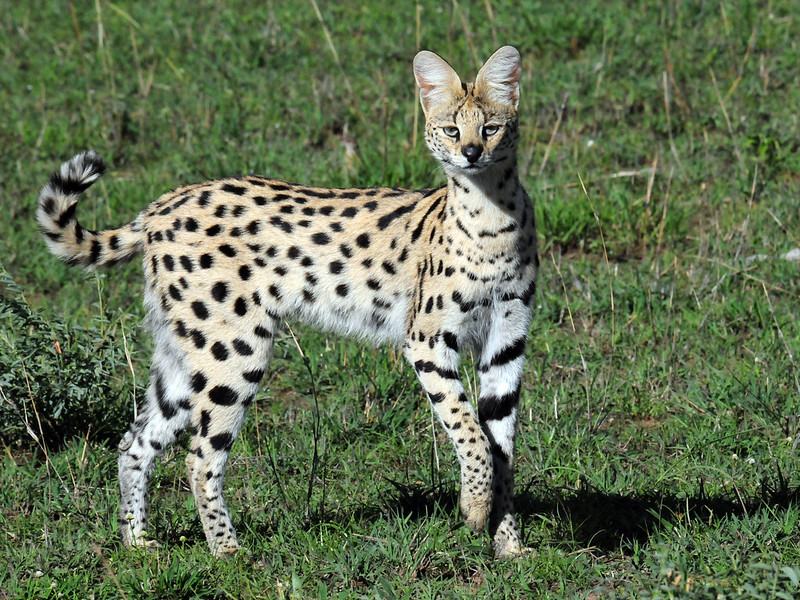
Serval Facts
- The most frequently used common name for this highly unsual looking wild cat is the surprisingly short term of Serval. The mammal does have a few other, less often used titles, though. These include such tags as bush cat and giraffe cat, among others.
- Within the scientific community, however, it’s perhaps better known by its technical designation. That term is a moderately difficult one for the layperson to pronounce, though. That’s because the animal holds the formal epithet Leptailurus serval.
- The intriguing creature received that honorific due to the efforts of Johann Christian Daniel von Schreber. The German naturalist accomplished the first recognition of it as a separate and distinct species. He managed that scientifically noteworthy feat in 1776.
- It also holds a certain degree of distinction in the annals of science. This status occurs due to several reasons. The animal represents the only member of its genus, for one. Yet, ongoing research also recognizes a current total of three existing subspecies.
- Thankfully, the amazing Serval appears to be maintaining a population base that’s both stable and sufficient. That pleasant condition further seems to hold true across the entirety of its range. The IUCN therefore presently lists the feline as Least Concern.
- The biological wonder nevertheless faces several potential threats to its existence as a species. Like most forms of life on the planet, most of these dangers stem from the actions of man. They include the perils of habitat loss and ongoing climate change.
Related Articles
Serval Physical Decsription
The fascinating Serval garners a great deal of attention from those fortunate enough to encounter one. It generally does so, however, due more to its appearance than sheer phsyical dimensions. That’s true since, in that respect, it’s roughly average-sized for a wild cat.
Like most mammals, the feline demonstrates a certain degree of the physiological characteristic of sexual dimorphism. In its specific case, though, this trait only manifests itself in terms of size. Otherwise, the two genders appear outwardly identical in form.
Individuals of both sexes of the species attain a height at the shoulder that averages 21 – 24 in (54 – 62 cm). In terms of head-and-body length, however, it evolved a very elongated form. This measurement typically ranges from approximately 26 – 39 in (67 – 100 cm).
Weights also vary, but to a significantly greater extent. This is where the males and females distinguish themselves, if only slightly. The males usually generally possess a much stockier build than their female counterparts. Masses thus range from 18 – 40 lb (8 – 18 kg).
In coloring, specimens present the same basic pattern, regardless of gender. This mainly consists of a brownish-yellow to golden-yellow background. Yet, it’s also extensively marked with large black spots and stripes, appearing in widely varying patterns among individuals.
It’s the body of the Serval that draws the most attention, though. That’s due to the presence of several distinctive characteristics. These include the development of a comparatively small, elongated head. This also sits atop an extra-long neck, compared to others.
The animal further sports a short tail, averaging only 12 in (30 cm), and having a black tip. Another highly notable trait is the legs of the cat. That’s because these rank as the longest of any known species of feline, relative to overall body size. Even its toes develop as elongated.
- Kingdom: Animalia
- Phylum: Chordata
- Class: Mammalia
- Order: Carnivora
- Family: Felidae
- Genus: Leptailurus
- Species: L. serval
Serval Distribution, Habitat, and Ecology
The incredible Serval evolved as native to a moderately large section of the earth’s surface. The general area in which that evolution took place likely won’t surprise many people, however. That’s true since it developed as endemic to a portion of the continent of Africa.
There, the eye-catching animal primarily dwells in the southern section of that greater range. Smaller concentrations do also occur in the northern part of the continent, though. In this part of its territory, it’s only known to appear naturally in the country of Morocco.
Nature also provided this feline with a moderate degree of adaptability regarding its choice of habitat. Due to this flexibility in that respect, the creature principally inhabits regions of cork oak forests or semi-arid regions. It also avoids fully arid areas and rainforests.
Further displaying its ability to adapt, it also lives in zones composed of moorlands, grasslands, and bamboo thickets. Populations also dwell at altitudes of up to 12,500 ft (3,800 m) above sea level. It also prefers close proximity to bodies of water, such as wetlands.
The marvelous Serval evolved as dirunal in nature, and is therefore active by both day and night. It does typically prefer to rest during the hottest part of the day, though. This activity usually occurs in the shade provided by trees or larger bushes in its local area.
Like many of its relations, this wild cat evolved as carnivorous in nature. As a general principle, its prey consists of various small creatures. These include such species as birds, rodents, frogs, insects, and small reptiles. Its own predators include hyenas and leopards.
Species Sharing Its Range
Check out our other articles on 5 Beautiful Black Sea Species, Fire Salamander, Mount Jade, Orange Jewelweed, Indian Vulture, Striped Possum, Mountain Apollo, Wolf Eel, Mangrove Monitor
